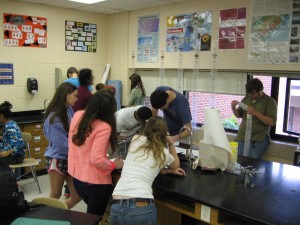Good COMMUNITY in a classroom can make material click for students, and enhance learning tremendously. Teachers know it and students feel it when true COMMUNITY is being experienced. Do you remember your favorite teacher in high school? What was the atmosphere like in the room? As a teacher how do you try to create that type of atmosphere today? For me, my biology and P.E. teacher Mr. Springer was that kind of teacher. He gave us parameters and expectations in the classroom and showed us he valued us and wanted us to succeed. He brought us together like a little family who showed RESPECT (Value #1) for him and other classmates. We were productive toward the goals of learning biology and physical fitness. This type of COMMUNITY was a sweet experience for me!
Students in my Anatomy and Physiology Class in Community
Both Urie Bronfenbrenner’s bio ecological model and Albert Bandura’s social learning theory (see Life-Span Human Development) can serve as backbones for educators in the classroom. Bronfenbrenner’s model shows how students are a part of different sizes of communities. Bandura’s theory reveals how social and moral behavior is learned through interaction with others.
Students see COMMUNITY demonstrated by the way teachers communicate verbally and non-verbally to create a healthy classroom atmosphere. This happens through careful teacher lesson planning that reflects the value of student participation. My goal is to create COMMUNITY as early as I can when stepping into a new classroom by drawing students into the classroom experience with others.
One of the biggest ways to create COMMUNITY is by forming thoughtful small groups. My personal history has revealed that life change happens in small groups. Small groups can be formed by ability levels or variety depending on the purpose. Changing up the small groups is key to progress.
Why do students like small group assignments, labs, and projects?
Students learn how to draw on each other’s strengths and support each other’s weaknesses. They can be more productive by accomplishing more in a shorter time. In addition, the transferable skills to the real world are a slam dunk for the teacher and the student. When students go to college and into the real world, working well in small groups within an organizational community is essential. How are you being intentional about developing COMMUNITY in your classroom? Research and experience says it can be one of the most rewarding things you do for your students!
Thanks for reading and stay tuned for the final Core Classroom Value of ENGAGE coming on Halloween! I will also be sharing the next blogging series for November.
Chris Morland, MS, CSCS
The view, opinions, and judgments expressed in this message are solely those of the author. The message contents have not been reviewed or approved by any other entity.

